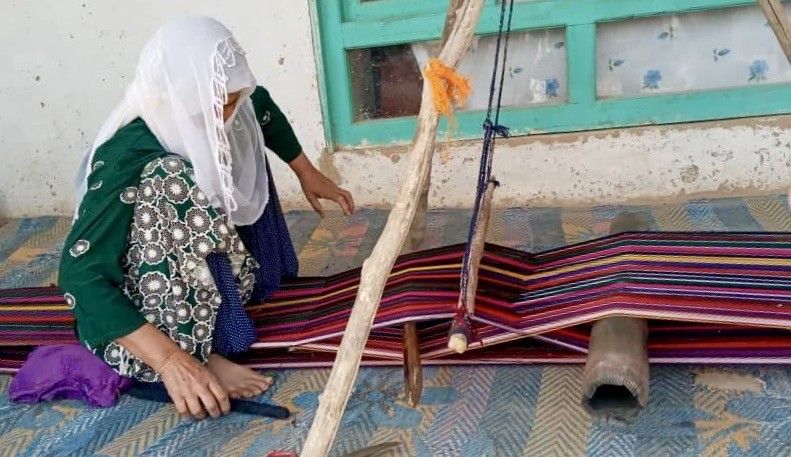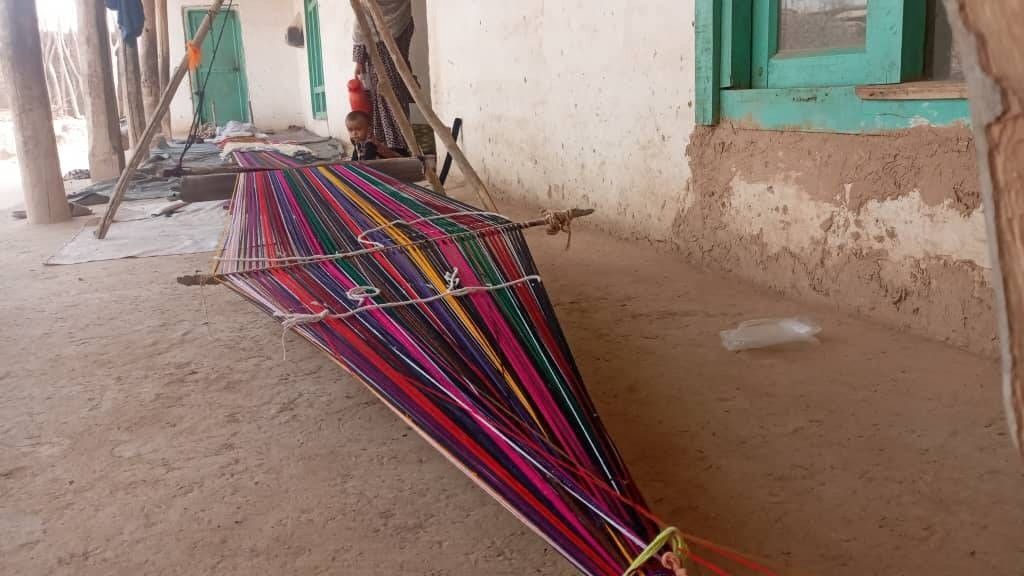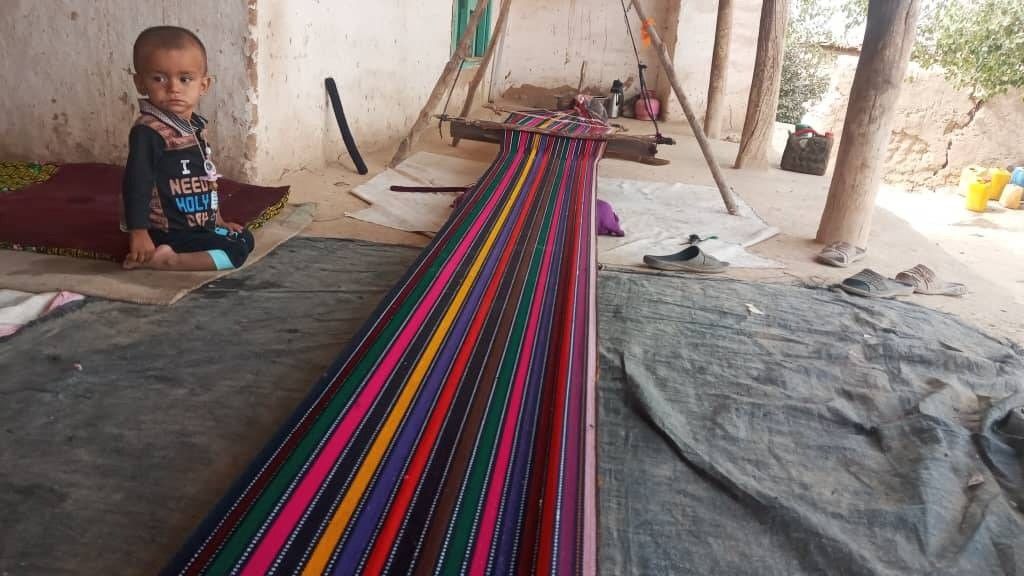Only the Dark Stops Her

— One Day in Afghanistan —
Reporting by Rahmatullah Bedar, edited by Mohammad Jawad and Brian Conley
TAKHAR — The clock ticks 8 am and I am walking on dirt roads lined with mud houses in a village of Yangi Qala district of northern Takhar province. I arrive at Bibi Razia Dawlati’s home. She is 52 years-old, her husband died years ago and she feeds her family of four by making a type of Afghan rug called a kilim. She welcomes me into her home.
The difference between a kilim area rug and a carpet or a pile rug is that whereas the design visible on a pile rug is made by individual short strands of different color being knotted onto the warps and held together by pressing the wefts tightly, kilim designs are made by interweaving the variously colored wefts and warps, thus creating what is known as a flatweave.
The time now is 8:45 and I am sitting in a room, drinking Shor Chai, on a kilim Bibi Razia made with her own hands. The room is made of mud, like many rural Afghan homes. One can tell by looking at it that the living conditions in this distant village are not very good.
Shor Chai, a tradition in northeastern Afghanistan, is a variation of milk tea. However, instead of using sugar to sweeten the tea like in India and Pakistan, people here add salt and crushed walnuts to it. The first and second sip can be a little hard to take in but by the third sip, one can get used to the taste and it is quite delicious.
Chickens and other domestic animals can also be seen in Bibi Razia’s yard. There is also a girl sweeping the yard to get rid of the dust that has set in during the windy nights. As Bibi Razia’s home is located on top of a hill, there is no sight of trees or leaves anywhere.
Bibi Razia heads towards the kilim she is making after we finish the tea. The kilim, designed in different colorful patterns, is laid out vertical in the hallway of her home. Bibi Razia busies herself making the kilim with the wooden piece in the middle of the carpet that beats the horizontal thread into place as she continues making the kilim, one thread line at a time.
Weaving carpets is a huge business in northern and northeastern Afghanistan. The business however can be very time consuming and has a slow process. Most families have several of their members weaving a piece of carpet that can take from 15 days to months, depending on the size, in their home.
The Director of Afghanistan Rugs and Carpet Center (ARCC), Diljam Manan Qassimy, has said that since Afghanistan does not have a sufficient channel of official trade for the volume of carpets available for export, most Afghan carpets are smuggled to Pakistan, marked as Pakistani products, then exported and sold to the outside world.
This results in the revenue which Afghan carpets can make to go down significantly.
Hanifa, a woman working with Bibi Razia, is busy tucking the warps in an orderly fashion.
“She is my neighbor, I pay her 200 Afghanis ($2.21) a day to help me,” Bibi Razia says.
Perhaps Bibi Razia and Hanifa’s pain are the same, or their common ground is that Hanifa, like Razia, lost her husband and works as a kilim maker every day to be able to feed her family. Hanifa avoids talking to me due to the stigma of women talking to strange men.
Ms. Razia is busy weaving the kilim while speaking with me.
“40 years have passed on since I got married. I have a son and two daughters, 22 year-old Nizamuddin, 19 year-old Khalisa and 17 year-old Royeda,” Bibi Razia tells me.
According to Razia, poverty forced her son to migrate to Iran a couple of years ago and work there to help feed their family.
Bibi Razia has worked on this kilim for the past 20 days but it is far from completion.
“An average room size kilim would take about 10 days for normal, strong people but it would take people like me between 20 to 30 days to finish,” Razia says.
Ms. Razia learnt how to make kilims from her mother and grandmother. She, like her mother, has spent nearly all her life in this profession. Her look and the strands of white in her hair tells the story of a woman who has spent all her life designing rugs for the brides of her village.
It’s now 11 am and the sun is entering the hallway where Razia and her helper Hanifa are working. Hanifa’s kids are trying to get their mother’s attention by jumping around from one side of the kilim to the other. Another neighbor walks in to spend time with Razia but turns around after seeing me.
There are no literate members in Razia’s family. I have sat here for hours but there has been no talk of education, books, pens, politics, culture, market or economy. The only things I hear are what to cook for lunch, what to have for dinner, do they have enough wheat to flour for tomorrow or when will Razia finish the kilim her neighbor has ordered and get her paycheck.
The result of Razia’s effort since this morning is 5 centimeters of the kilim are complete after non stop work by her and her helper.

At 12:30 in the afternoon Bibi Razia stops working. We sit down on another kilim she has personally made to eat lunch that her daughters have prepared. The tablecloth used for lunch was also weaved by her. We eat a simple but delicious meal of Okra with flatbread made at home. After lunch Ms. Razia and Hanifa pray and get back to work. This is her daily routine.
Razia and Hanifa get busy working while their female neighbors visit them one after the other as usual and spend some time watching her work as well as chat about their families, how her work is going, usual talk between women.
“You can see how hard we have to work to finish a meter of the kilim, we have to keep our backs and heads bent forward for days until the job is complete and then sell it for between 2 to 10 thousand Afghanis($20–110.00),” Bibi Razia tells me.
Razia’s precise moves and concentration while making the kilim makes me feel like she is made for the job and this is her entertainment and her world. An old woman sitting across from Razia tells her, “You didn’t even make me the tablecloth you promised to make…”
But Razia continues her work and I don’t know when she will finish. The old woman sitting across from me now says, “She (Razia) will even work at night if she could see properly.”
Razia works in two different ways; in one her customers give her all the material she will need for making the kilim and she will charge the customers a fee while in the other, she buys all the material and sells the kilim for a higher price.

“Previously people who were about to get married would order the kilims and we would work day and night to complete the job but the demand for handicrafts have reduced as machine based carpets have hit the market,” Razia says.
According to Razia, most of her customers order tablecloths, area rugs, niche rugs, saddlebags and sacks. There are several saddlebags and sacks hanging from the wall where we are sitting. She says sacks and saddlebags are popular among farmers who use them to carry their goods.
Although I do not see a single customer throughout the day, Ms. Razia says she has as much work as she wants but cannot fulfill all customer demands by herself, that’s why she hires help.
At the moment Razia is making a kilim that is 50 meters long and half a meter wide. Ms. Razia says, “kilims usually have a shorter width and longer length. People cut off the kilims to their desired length and lay it side by side to fill the room.”
It is now 5:30 pm and the day is getting dark. Razia stops her work here, collects the tools from under her feet and puts the equipment in the saddlebag hanging from the wall to keep it away from the children.
She faces me and says, “It’s now dark and my eyes cannot see properly anymore, I should quit before ruining the customer’s order.”

